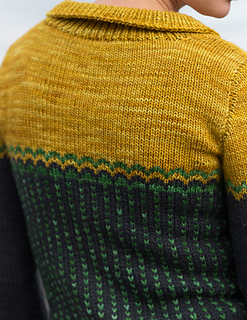patterns > Malabrigo Freelance Pattern Project >  North Sea and 1 more...
North Sea and 1 more...
> Marsh Marigold






Marsh Marigold
Gauge 18 sts and 28 rows/rounds = 4”/10cm in stockinette stitch on larger needles
18 sts and 22 rows/rounds = 4”/10cm in stranded colorwork pattern on larger needles (go up in needle size if necessary)
Sizes 32.5 (35, 38.75, 41.25, 45, 49.25)“/82.5 (89, 98.5, 105, 114.5, 125)cm bust circumference; modeled with no ease.
Materials Malabrigo Merino Worsted - 100% merino wool; 210yd/192m per 100g skein;
MC: Blue Graphite; 3 (3, 4, 4, 4, 5) skeins
CC1: Verde Adriana; 1 (1, 1, 2, 2, 2) skeins
CC2: Frank Ochre; 2 (2, 3, 3, 3, 4) skeins
US 7/4.5mm: 32”/80cm circular needle and/or DPNs
US 8/5mm: 32”/80cm circular needle and/or DPNs (see Tips) or sizes needed to obtain gauge
Size G/4.5mm: crochet hook, optional, for securing steeks
Sharp scissors
12 locking stitch markers
Waste yarn
9-12 x .75”/2cm buttons
Notes
This stranded colorwork cardigan is named for a cheerful, yellow wildflower found throughout the Northern Hemisphere, including all over Scandinavia, where it heralds spring after long, harsh winters. The sweater features an updated, flattering silhouette and a simple zigzag motif common to colorwork patterns from around the region. It’s intended to be worn with minimal negative ease and skim the mid-hip. Strategically placed motifs slim the waist and draw attention up to your face. Wear it over a light tee or tank and relish the delightful, next-to-skin softness of Malabrigo Merino Worsted.
The cardigan is knit from the bottom up in the round with a steek panel at the center front. The sleeves are picked up from the armholes and knit down with short row shaping for the shoulders. The the button band and shawl collar are knit last, with short rows used again for the collar.
Tips
- Be sure to check your gauge in both solid stockinette and stranded patterns. Stitch gauge is more important than row/round gauge - you can add or subtract rounds from the solid body section to adjust the length as necessary.
-You’ll need needles for working small and large circumferences in the round for this sweater. If you prefer to use Magic Loop for small circumferences, you can forgo the DPNs in each size.
-On any row/round after working short rows, work wrapped stitches together with wraps as you come to them.
-You can secure your steek lines for cutting with a column of single crochet (as used in the sample) or with machine stitching. A Google search for either method will turn up many excellent tutorials.
159066 projects
stashed
87761 times
- First published: December 2014
- Page created: December 18, 2014
- Last updated: December 18, 2014 …
- visits in the last 24 hours
- visitors right now




